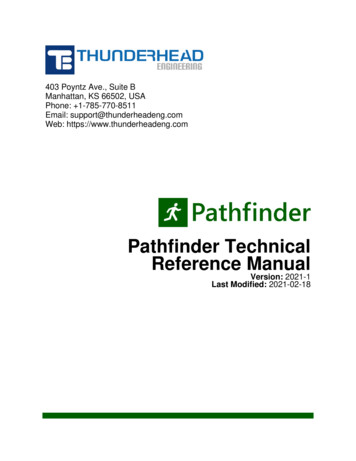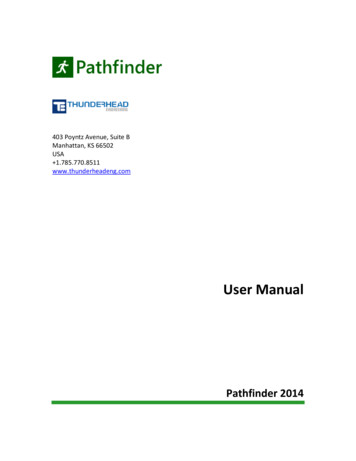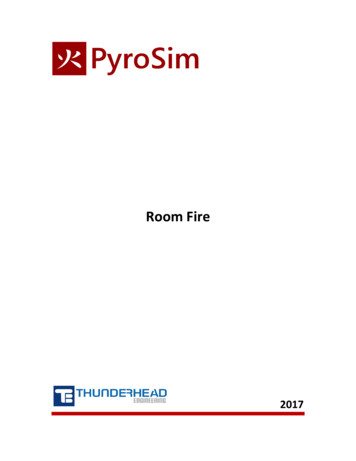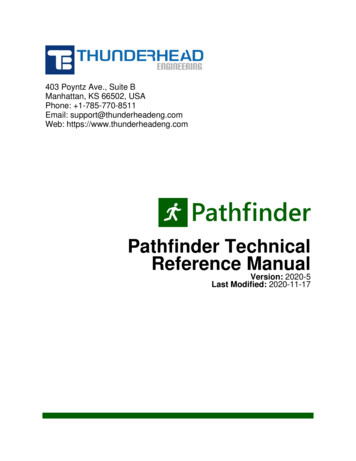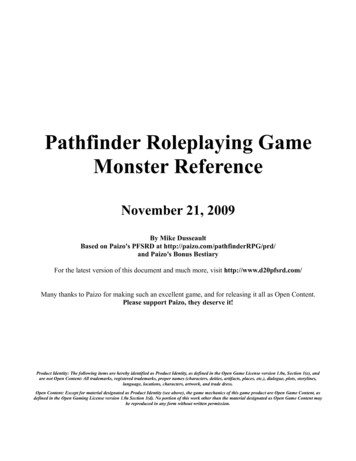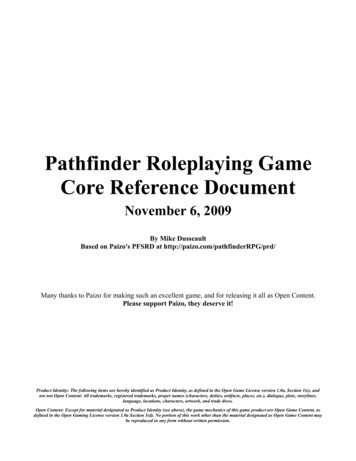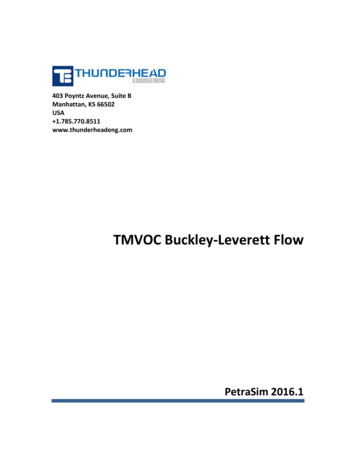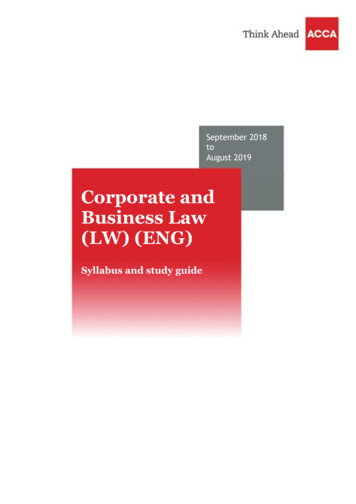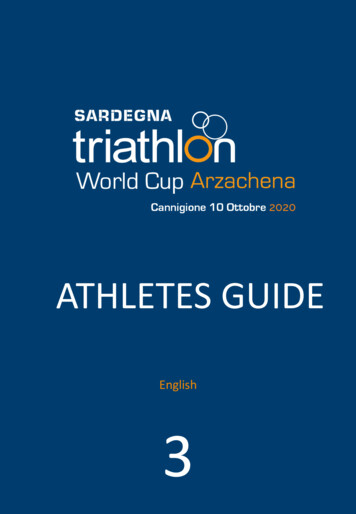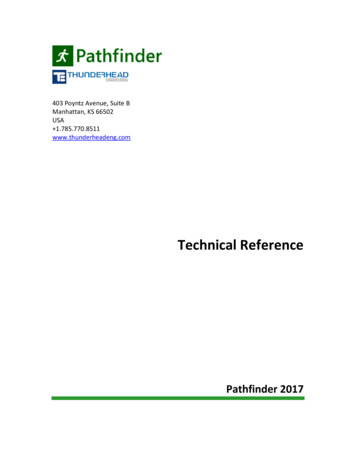
Transcription
403 Poyntz Avenue, Suite BManhattan, KS 66502USA 1.785.770.8511www.thunderheadeng.comTechnical ReferencePathfinder 2017
DisclaimerThunderhead Engineering makes no warranty, expressed or implied, to users ofPathfinder, and accepts no responsibility for its use. Users of Pathfinder assume soleresponsibility under Federal law for determining the appropriateness of its use in anyparticular application; for any conclusions drawn from the results of its use; and for anyactions taken or not taken as a result of analyses performed using these tools.Users are warned that Pathfinder is intended for use only by those competent in thefield of egress modeling. Pathfinder is intended only to supplement the informedjudgment of the qualified user. The software package is a computer model that may ormay not have predictive capability when applied to a specific set of factualcircumstances. Lack of accurate predictions by the model could lead to erroneousconclusions. All results should be evaluated by an informed user.ii
AcknowledgementsThis work was partially funded by a Small Business Innovative Research (SBIR) grant bythe United States National Science Foundation.We would like to thank Rolf Jensen and Associates for their assistance with testing andother suggestions that helped guide the development of the simulator.In addition, we would like to thank all of the beta testers who contributed feedback onthe web forums and via email.iii
Table of ContentsDisclaimer. iiAcknowledgements . iiiTable of Contents. ivFigures . viiOverview .8Example Problem IMO Test 10 . 8Geometry . 11Geometry Subdivision . 11Open Space (Room and Ramps) . 12Doors (Connecting) . 12Stairs. 13Ramps. 13Doors (Exit). 13Behaviors and Goals . 14Seek Goals . 14Idle Goals. 14Goals . 14Room-filling . 15Door Distance Map . 16Ideal Seek Direction . 17Decide Whether to Move . 17Paths . 18Path Planning (Locally Quickest) . 18Door Choice. 19Backtrack Prevention . 20Path Generation . 20Path Following. 21Path Following in SFPE Mode . 23SFPE Mode Parameters. 23Velocity . 23Base Speed, vb . 24Density, D . 25Speed Modifiers and Constants . 26Movement through Doors . 26Collision Handling/Response . 27Path Following in Steering Mode . 28Velocity . 28Acceleration . 28iv
Estimation of Occupant Density, D . 29Steering . 30Seek . 30Idle Separate . 30Avoid Walls . 31Avoid Occupants . 32Seek Separate . 32Seek Wall Separate . 33Lanes . 33Pass . 33Cornering . 34Final Direction Cost . 34Evaluating Movement . 35Occupant States . 35Effect on Steering Behavior . 36Effect on Sample Directions . 36Priority. 36Resolving Movement Conflicts . 37Free Pass . 39Collision Avoidance/Response . 39Movement through Doors . 40Vehicle Agents . 41Assisted Evacuation . 42Assist Occupants Goal . 42Wait for Assistance Goal . 43Coalition Formation Algorithm . 44Elevators. 46Idling. 46Elevator Calling . 46Pickup . 46Countdown Timer . 47Loading . 47Discharge. 47Solution Procedure . 48File Format . 49Results . 68Occupant Contours . 68Density . 69Level of Service . 70Speed . 70Normalized Speed . 70Usage [Instantanteous] . 70Usage [Accumulated] . 71v
Time to Exit . 71Average . 71Maximum . 71Integrate. 71Calculation of Factional Effective Dose. 72Calculation of Measurement Region Quantities . 73References . 74vi
FiguresFigure 1: Cabin area (from IMO, 2002) . 9Figure 2: Steering mode results for IMO 10 problem showing occupant movement. Notehow highlighted occupants move to their assigned exits. . 10Figure 3: SFPE mode result for IMO 10 problem. Note that multiple occupants canoccupy the same space. . 10Figure 4: A simple building model and the corresponding navigation mesh . 11Figure 5: Rooms, doors, exits and the navigable mesh in the IMO Test 10 problem . 12Figure 6: Sub-divided room for door distance map . 16Figure 7: Door distance map . 17Figure 8: An occupant's planned path with waypoints shown . 21Figure 9: Paths and waypoints for the IMO Test 10 analysis . 22Figure 10: k as a function of step slope . 25Figure 11: Average Longitudinal and Lateral Spacing of Pedestrians in a Traffic System(Figure 3.4 of Fruin's pedestrian planning and design) . 29Figure 12: Sample inverse steering directions . 30Fi
Pathfinder is an agent-based egress simulator that uses steering behaviors to model occupant motion. It consists of three modules: a graphical user interface, the simulator, and a 3D results viewer. Pathfinder provides two primary options for occupant motion: an SFPE mode and a steering mode. The SFPE mode implements the concepts in the SFPE Handbook of Fire Protection Engineering [Nelson and .
